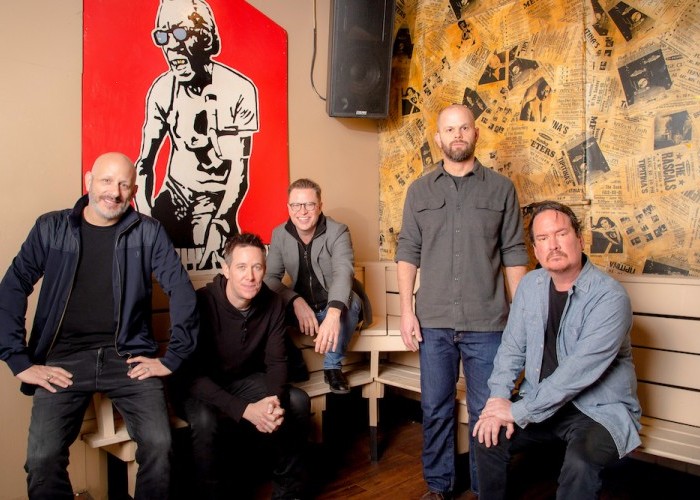Oct 28, 2025 10:47 AM
In Memoriam: Jack DeJohnette, 1942–2025
Jack DeJohnette, a bold and resourceful drummer and NEA Jazz Master who forged a unique vocabulary on the kit over his…

During two decades of performing at Tipitina’s, members of Galactic have amassed an abundance of memories tied to the historic New Orleans venue.
(Photo: Erika Goldring)It’s the kind of open-minded, people-centric leadership style fans might expect from Galactic, a rhythm- and groove-driven quintet that long has welcomed outside voices into its mix. Whether those voices are instrumentalists like trumpeter Shamarr Allen, trombonist Corey Henry and percussionist Mike Dillon, or the variety of singers with whom the group has worked, Galactic has displayed a gift for forging symbiotic musical relationships. The results are audible, packing new dynamics into the fundamental sound they’ve developed during about 25 years together.
The group started out in the early ’90s as Galactic Prophylactic (the name of a product in a 1982 Saturday Night Live advertising spoof). By 1996, the band had ditched the condom reference in its name and enlisted Theryl “Houseman” DeClouet as a featured singer. Twenty-odd years their senior, DeClouet’s smooth, r&b-inflected vocals added depth and warmth to the sound of what already was a solid New Orleans-flavored funk band.
Back-to-back spins of the band’s 1996 debut, Coolin’ Off, and its second album, 1998’s Crazyhorse Mongoose, suggest the singer’s influence extended beyond the tracks on which he was featured. Within a couple of years, Galactic’s music had started to mature, its grooves were deeper and its songs were opening up in a more relaxed, soulful way. Time on the road certainly contributed to that growth, but those recordings and the live performances that came between them indicated DeClouet did, too.
After his death last year, the band hosted a homegoing celebration at Tipitina’s, where they’d recorded their first live album together in 2001.
Galactic’s final recording with DeClouet, 2003’s Ruckus, sparked another key shift for the band. Having tasked Dan the Automator with producer duties because of his remix and DJ work, they found their own vision for the album involved a bigger leap into electronic music than where the Gorillaz producer was headed. Ellman and Mercurio ultimately finished producing the album, learning the ropes from Mike Napolitano as they went. The pair has produced every Galactic album since.
“Ruckus was the first time we had our own studio,” Mercurio explains.
As if intuiting the rest of his thought, Ellman continues: “That creates a whole different scenario, not being forced into being in a rehearsal room and then going into a studio you’ve paid to be in for a specific time. Instead, it’s at our leisure to work and chip away at ideas.”
Ruckus also signaled a move toward what would become a lasting use of electronics, ranging from effects pedals and drum phasers to the samples and beats that appeared on 2007’s From The Corner To The Block. That album marked a new level of involvement for Ellman and Mercurio as producers.
The result was an innovative use of New Orleans hip-hop concepts, including those long embraced by the brass band community. The organic funk remained while collaborations with the Soul Rebels (arguably the first brass band to make ’90s hip-hop a cornerstone of its sound) and Digable Planets alum Ladybug Mecca underscored the band’s ability to find inspiration in—and to inspire—outside voices.
All the band’s albums since then, including the tightly wrought, pop-hook laden Already Ready Already, have incorporated different singers and often different styles, while weaving in New Orleans references, usually in unexpected ways. (Examples include a riff on the theme song of New Orleans horror-movie TV host Morgus the Magnificent and the decision to filter Allen Toussaint’s voice into the song “Bacchus” on 2010’s Ya-Ka-May.)
On the new album, guest contributors include the band’s touring vocalist, Erica Falls, plus other New Orleans-based singers, like Princess Shaw and Miss Charm Taylor, who put new spins on what Falls calls Galactic’s “well-oiled machine” of a sound. The guests add a fresh feel that never compromises the band’s bright and rhythm-driven ensemble voice, which stretches out on instrumental tracks bookending the album (“Already” and “Ready Already”).
Galactic kept things much shorter than usual with this album, too.
“We had 14 or 15 songs,” Ellman explains. “We decided to make a really concise album, the concept being to put out more music on a regular basis, instead of a 14-song record every two or three years.”
Ellman and Mercurio say they sometimes find themselves intentionally striving to make a song “sound more Galactic” in the studio. With its swaggering horn lines, Ellman’s blues-soaked harmonica work and a song structure that keeps the energy moving alongside Miss Charm Taylor’s growl-tinged voice, the tune “Clap Your Hands” exemplifies the Galactic aesthetic.
“We’re always trying to be better songwriters,” says Ellman. “We’re trying to write better bridges, better choruses. I don’t really think it used to be as much like, head, solo, head, solo—the records were always more than that. But we’re always thinking of the song. We have to think of the different singers, the different people at the front of the song, and that sometimes changes the direction of the song.”
Already Ready Already mines the contemporary New Orleans music landscape for its ideas and direction. There’s a funeral reference, but it’s no traditional jazz funeral. Instead, it’s the earworm “Dance At My Funeral,” which features a stop-start melody and the vocals of Boyfriend, an electro-cabaret rapper with a penchant for subversive feminist themes. On this track, Galactic provides the musical lighter fluid, and Boyfriend adds the spark.
Falls is featured on the track “Touch Get Cut,” a song that explores dark subject matter, but which actually had humorous origins.
“On the road with the guys, if I would have some food left over that I wanted to keep,” Falls says, “I would write on the top of the container, ‘Touch, get cut.’” She laughs.
“When they were working on this tune, it was supposed to be something else, but then Ben got the idea to say, ‘Touch, get cut.’ From there, it went to what’s happening with women and the #MeToo movement. It was sort of under that realm until they brought it to me. ... Then I put my own little spin to it, lyrically. Later, we came together as a group after working on it separately to match up our ideas for the track.”
Other songs on the new album came together more quickly, including “Going Straight Crazy,” featuring Princess Shaw. Ellman and Mercurio lined up three works in progress for her to hear and she zeroed in on the one they secretly thought was the best fit.
“When she heard that one, she got all excited and sang some scratch vocals that sounded really close to what the song is now,” Mercurio recalls.
He adds that he was afraid Moore, who sometimes hears material later than other band members, would hate it: “I was certain he was going to be like, ‘It’s just kicks and snaps, and this sucks,’” Mercurio admits, laughing.
“No, hearing that for the first time, I was like, ‘Damn, this is great.’ Instantly,” Moore assures him.
When Ellman points out that “Stanton loves the strong hook” (like the one in “Going Straight Crazy”), Moore explains that he intentionally has “tried to learn to listen for the ‘big picture’—the song—and not just the drums.” Over time, Moore says, “I’ve learned to trust the process.”
When it comes to song selection, there is a lot of give-and-take among the bandmates. “Everyone has equal veto power,” says Ellman, who credits the band’s longevity in part on its ability to work within a democratic framework.
That doesn’t just apply to the core band, though. Asked what stands out most to her about the creative process of her work with Galactic, Falls immediately replies, “Everyone is involved.”
Between shows at Tipitina’s, the band will perform at numerous high-profile festivals this year, including the French Quarter Festival (April 11) and the Jazz & Heritage Festival (May 4), both in New Orleans; and the High Sierra Music Festival, taking place July 4–7 in Quincy, California.

Jack DeJohnette boasted a musical resume that was as long as it was fearsome.
Oct 28, 2025 10:47 AM
Jack DeJohnette, a bold and resourceful drummer and NEA Jazz Master who forged a unique vocabulary on the kit over his…

Always a sharp dresser, Farnsworth wears a pocket square given to him by trumpeter Art Farmer. “You need to look good if you want to hang around me,” Farmer told him.
Sep 23, 2025 11:12 AM
When he was 12 years old, the hard-swinging veteran drummer Joe Farnsworth had a fateful encounter with his idol Max…

D’Angelo achieved commercial and critical success experimenting with a fusion of jazz, funk, soul, R&B and hip-hop.
Oct 14, 2025 1:47 PM
D’Angelo, a Grammy-winning R&B and neo-soul singer, guitarist and pianist who exerted a profound influence on 21st…

Kandace Springs channeled Shirley Horn’s deliberate phrasing and sublime self-accompaniment during her set at this year’s Pittsburgh International Jazz Festival.
Sep 30, 2025 12:28 PM
Janis Burley, the Pittsburgh International Jazz Festival’s founder and artistic director, did not, as might be…

Jim McNeely’s singular body of work had a profound and lasting influence on many of today’s top jazz composers in the U.S. and in Europe.
Oct 7, 2025 3:40 PM
Pianist Jim McNeely, one of the most distinguished large ensemble jazz composers of his generation, died Sept. 26 at…